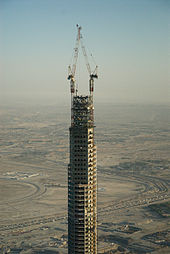It is an understatement to say that Burj Khalifa represents the state-of-the-art in building design. From initial concept through completion, a combination of several important technological innovations and innovation structural design methods have resulted in a superstructure that is both efficient and robust.
The tower was constructed by Samsung C&T from South Korea, which also did work on the Petronas Twin Towers and Taipei 101.Samsung C&T built the tower in a joint venture with BESIX from Belgium and Arabtec from the UAE.Turner was the project manager on the main construction contract.Hong Kong-based Far East Aluminum combined to provide the exterior cladding for Burj Khalifa.
The contractor and the engineer of record was Hyder Consulting.Under UAE law, the contractor and the engineer of record is jointly and severally liable for the performance of Burj Khalifa.
The primary structure is reinforced concrete. Putzmeister created a new, super high-pressure trailer concrete pump, the BSA 14000 SHP-D, for this project.Burj Khalifa's construction used 330,000 m3 (431,600 cu yd) of concrete and 55,000 tonnes (61,000 short tons; 54,000 long tons) of steel rebar, and construction took 22 million man-hours.In May 2008 Putzmeister pumped concrete with more than 21 MPA ultimate compressive strength of gravel to surpass the 600 meters weight of the effective area of each column from the foundation to the next fourth level, and the rest was by metal columns jacketed or covered with concrete to a then world record delivery height of 606 m (1,988 ft),the 156th floor. Three tower cranes were used during construction of the uppermost levels, each capable of lifting a 25-tonne load. The remaining structure above was constructed of lighter steel.

In 2003, 33 test holes were drilled to study the strength of the bedrock underlying the structure. "Weak to very weak sandstone and siltstone" was found, just metres below the surface. Samples were taken from test holes drilled to a depth of 140 metres, finding weak to very weak rock all the way.The study described the site as part of a "seismically active area".
Over 45,000 m3 (58,900 cu yd) of concrete, weighing more than 110,000 tonnes (120,000 short tons; 110,000 long tons) were used to construct the concrete and steel foundation, which features 192 piles; each pile is 1.5 metre in diameter by 43 m in length, buried more than 50 m (164 ft) deep.The foundation was designed to support the total building weight of approximately 450,000 tonnes (500,000 short tons; 440,000 long tons). This weight was then divided by the compressive strength of concrete of which is 30 MPa which yielded a 450 sq.meters of vertical normal effective area, which then yielded to a 12 meters by 12 meters dimensions.A cathodic protection system is under the concrete to neutralize the groundwater and prevent corrosion.
The Burj Khalifa is highly compartmentalised. Pressurized, air-conditioned refuge floors are located every 13 floors (in floors G, 13, 26, 39, 52 etc.) where people can shelter on their long walk down to safety in case of an emergency or fire.
Special mixes of concrete were made to withstand the extreme pressures of the massive building weight; as is typical with reinforced concrete construction, each batch of concrete was tested to ensure it could withstand certain pressures. CTLGroup, working for Skidmore, Owings and Merrill, conducted the creep and shrinkage testing critical for the structural analysis of the building.
The consistency of the concrete used in the project was essential. It was difficult to create a concrete that could withstand both the thousands of tonnes bearing down on it and Persian Gulf temperatures that can reach 50 °C (122 °F). To combat this problem, the concrete was not poured during the day. Instead, during the summer months, ice was added to the mixture and it was poured at night when the air was cooler and the humidity was higher. Cooler concrete cures more evenly and is therefore less likely to set too quickly and crack. Any significant cracks could have put the entire project in jeopardy.